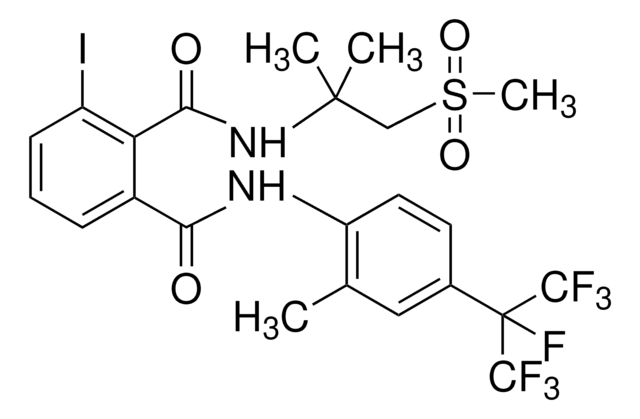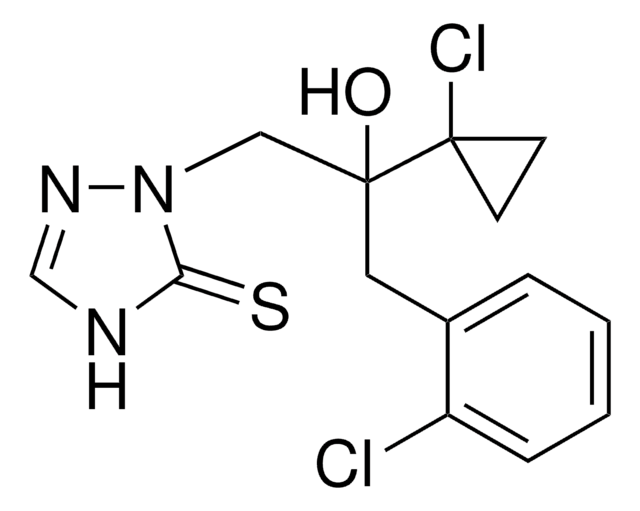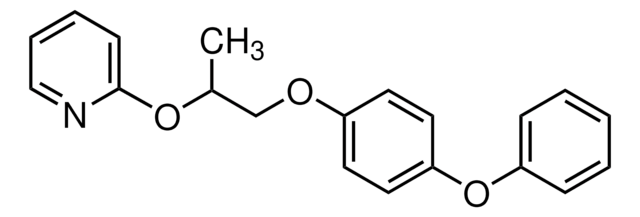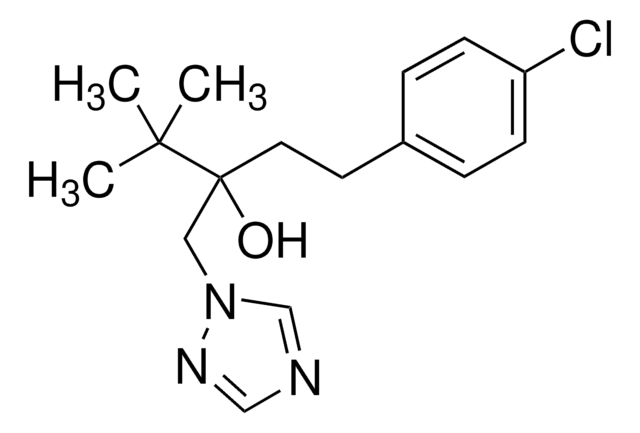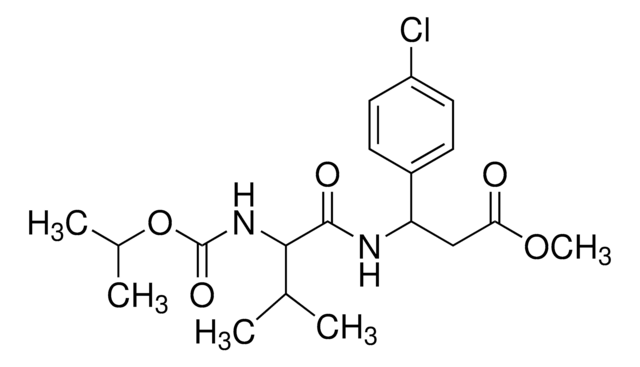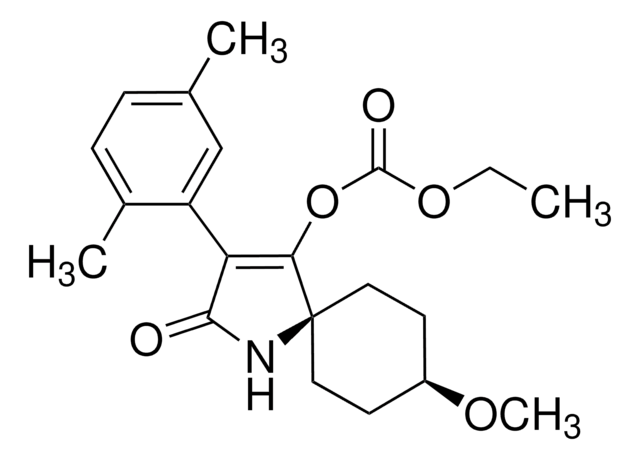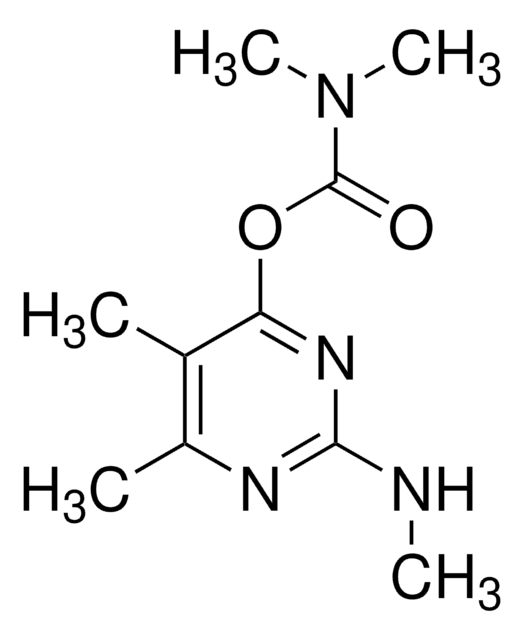Kluczowe dokumenty
32393
Pyridalyl
PESTANAL®, analytical standard
Synonim(y):
2-{3-{2,6-Dichloro-4-[(3,3-dichloro-2-propen-1-yl)oxy]phenoxy}propoxy}-5-(trifluoromethyl)pyridine, [2,6-Dichloro-4-(3,3-dichloroallyloxy)phenyl]-3-(5-trifluoromethyl-2-pyridyloxy)propyl ether
About This Item
Polecane produkty
klasa czystości
analytical standard
Poziom jakości
linia produktu
PESTANAL®
okres trwałości
limited shelf life, expiry date on the label
Zastosowanie
agriculture
environmental
Format
neat
ciąg SMILES
ClC1=C(OCCCOC2=NC=C(C(F)(F)F)C=C2)C(Cl)=CC(OCC=C(Cl)Cl)=C1
InChI
1S/C18H14Cl4F3NO3/c19-13-8-12(27-7-4-15(21)22)9-14(20)17(13)29-6-1-5-28-16-3-2-11(10-26-16)18(23,24)25/h2-4,8-10H,1,5-7H2
Klucz InChI
AEHJMNVBLRLZKK-UHFFFAOYSA-N
Szukasz podobnych produktów? Odwiedź Przewodnik dotyczący porównywania produktów
Opis ogólny
Pyridalyl has to be monitored in the Multiannual Control Programme for Pesticides Residues (MACP), run within the EU and EFTA in/on products of plant origin.
Pyridalyl was approved on 1 July 2014 under the Commission Regulation (EU) No 143/2014/EU as per the Regulation (EC) No 1107/2009 as amended by Commission Implementing Regulations (EU) No 540/2011 and 541/2011. Upon receiving an application to set the new MRLs for pyridalyl from the Evaluating Member State (EMS) following Article 9 of the Regulation on 14 January 2009, EFSA has proposed an MRL of 1 mg/kg for tomatoes, 1 mg/kg for aubergines (eggplants), 2 mg/kg for peppers, 0.2 mg/kg for cucurbits (inedible peel), 3 mg/kg for lettuce, and 0.1 mg/kg for cottonseed.
Zastosowanie
- To determine the toxicity of pyridalyl on each growth stage of 2 insect pest species and to evaluate its cytotoxicity on the Sf9 insect and CHO-K1 mammalian cell line using the trypan blue exclusion method
- To assess the lethal and sublethal effects of methoxyfenozide and pyridalyl on the larval ectoparasitoid Habrobracon hebetor
- Investigation of the molecular action of Pyridalyl via cytochrome P450 activity using non-selective cytochrome P450 inhibitor, 1-ABT (1-aminobenzotriazole)
- Evaluation of in vitro insecticidal activity of pyridalyl nanosuspension in comparison to technical material and commercial product against tomato fruit and shoot borer (Helicoverpa armigera)
- To elucidate the persistence behavior and risk assessment of pyridalyl in tomato, cabbage, and cultivated field soil over two consecutive seasons
Polecane produkty
Informacje prawne
Nie możesz znaleźć właściwego produktu?
Wypróbuj nasz Narzędzie selektora produktów.
Hasło ostrzegawcze
Warning
Zwroty wskazujące rodzaj zagrożenia
Zwroty wskazujące środki ostrożności
Klasyfikacja zagrożeń
Aquatic Acute 1 - Aquatic Chronic 1 - Skin Sens. 1
Kod klasy składowania
10 - Combustible liquids
Klasa zagrożenia wodnego (WGK)
WGK 3
Temperatura zapłonu (°F)
Not applicable
Temperatura zapłonu (°C)
Not applicable
Wybierz jedną z najnowszych wersji:
Masz już ten produkt?
Dokumenty związane z niedawno zakupionymi produktami zostały zamieszczone w Bibliotece dokumentów.
Nasz zespół naukowców ma doświadczenie we wszystkich obszarach badań, w tym w naukach przyrodniczych, materiałoznawstwie, syntezie chemicznej, chromatografii, analityce i wielu innych dziedzinach.
Skontaktuj się z zespołem ds. pomocy technicznej